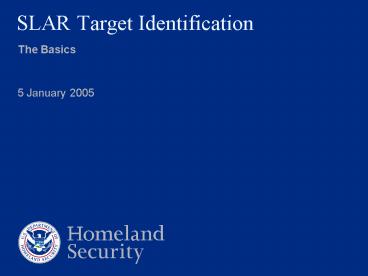SLAR Target Identification PowerPoint PPT Presentation
1 / 32
Title: SLAR Target Identification
1
SLAR Target Identification
- The Basics
5 January 2005
2
Background
- Implemented SLAR in 1983
- Enhanced SLAR with MSS5000 digital user interface
in 2001 - MSS5000 highlights digital data
recording/back-up, GPS, target list, and map - Data compression/image resolution degraded
ability to make target ID decisions based solely
on SLAR return - SLAR convergence of evidence aids target ID.
3
Convergence of Evidence
Using all available information to make informed
decisions regarding target identity
4
Convergence of Evidence (cont.)
- Primary use of SLAR is to detect targets
- However, SLAR can help identify targets,
particularly when it is used in conjunction with
FLAR image.
5
Convergence of Evidence (cont.)
Not all clues carry equal weight
6
Ship Indicators
- Side lobes from radar interference (radar flash)
- Gross target movement (position info from
successive passes) - Detectable wakes with bright return at apex
- Target position in regular fishing areas
- Size/Shape Solid, regular (elongated) shape
(length vs. width) - Target brightness
- Above indicators listed in order of precedence
(i.e., strength of support). - All targets in next section were visually
confirmed to be ships.
Very hard to use as ID aids
7
Side-Lobes (radar flash)ships
Side-lobes are a result of the interaction
between SLARs radar signal and a ships surface-
search radar
8
Gross Target Movement ships
Gross Target Movement provides confident
identification.
9
Detectable Wake ships
Ship wakes, when visible, are generally well
defined and can be detected for many miles
10
Ship Indicators (cont.)
- The following three indicators are much less
helpful for identification and must be carefully
considered - Target position in regular fishing areas
- Size/Shape Solid, regular (elongated) shape
(length vs. width - Target brightness
11
Target Positions/Bathymetry ships
Fishing vessels tend to fish along bathymetric
features and often line up. In general, icebergs
will not line up along isobaths. Target position
can be helpful but is not a good ID tool when
used alone.
12
Size/Shape ships
Warning Real-aperture radars tend to elongate
return from distant targets therefore, size and
shape of return does not necessarily indicate
actual target size and shape.
Ship
Iceberg
Irregular Shape and Brightness
Elongated and Uniformly Bright
13
Brightness ships
Uniformly bright targets are more likely ships
than icebergs. However, brightness is not a good
ID tool when used alone.
14
Iceberg Indicators
- Sea-ice wake
- Double image (function of target height)
- Iceberg micro-climate trail
- Faint, irregular shape/edges opposed to bright
uniformity of ships - Tone (shadow) varying shades of black and gray
- Pattern arrangement of targets, e.g., icebergs
aligned with wind and currents stress patterns
in sea ice caused by berg movement - Above indicators listed in order of precedence
- All targets in next section were visually
confirmed to be icebergs.
15
Sea Ice Wake bergs
Sea Ice
A sea-ice wake results from sea ice moving around
an iceberg. Sea ice is driven by the wind and
will generally move faster than icebergs, which
are generally current-driven. In this frame the
sea ice is moving toward the upper-right.
Iceberg
Wake(open water)
16
Double Image bergs
Double Image is a function of target height.
Tall targets tend to induce the double bounce.
Many icebergs are tall enough to cause a double
image, but most ships are notbut still some are.
(Hope for good visibility.)
17
Micro-climate bergs
Icebergs can create a micro-climate as they
modify the surrounding air. A wake will extend in
the direction that a target came from while a
vapor trail will be directed by the wind. In the
case of multiple icebergs, all the vapor trails
will be in the same direction, but vessel wakes
will likely be oriented in different directions.
18
Shape/Edges bergs
Faint Irregular Shape and Brightness
Target shape/edges are helpful but not diagnostic
alone. (Get that FLAR working or those clouds
out of the way!)
19
Pattern/Tone (and shadow) bergs
Tone and pattern are helpful but not diagnostic
alone.
20
Atmospheric and Oceanographic Effects
- Atmospheric conditions, while normally invisible
to radar, can be thick/reflective enough to
return RF. - Oceanic features (sea surface temperature) alter
surface roughness, forcing a modification of RF
return.
21
Atmospheric Effects - Clouds
Targets can be difficult to detect in the complex
background caused by clouds/precipitation.
22
Atmospheric Effects - Weather
Targets can be difficult to detect in the complex
background caused by clouds/precipitation.
23
Atmospheric Effects - Weather
24
Oceanographic Features
Relatively Cold Water
Though not target- masking, oceanographic
features may warrant changing radar settings
(gain, brightness, etc.) to maximize detection.
Relatively Warm Water
25
Practice Exercises
- The following slides include target images.
- Using convergence-of-evidence logic, determine
target identity.
26
The Test (1 of 6)
- ICEBERG
- Tone
- Shape
- Shadow
27
The Test (2 of 5)
- SHIP
- Side lobes
- (Radar Flash)
- Wake
- Brightness
28
The Test (3 of 5)
- ICEBERG
- Micro-Climate
- Shape
29
The Test (4 of 5)
- SHIPS
- Difficult to
- identify w/o other info
30
The Test (5 of 5)
- ICEBERG
- Shape
- Open waterwake in sea ice
31
In Review
- The SLAR/MSS5000 combination is an excellent
asset for Ice Patrols mission. - SLAR alone is not the best identification tool
for Ice Patrol operations. - SLAR can provide helpful clues to target
identity, but ideal clues are not typical. - IIP uses SLAR primarily to detect targets.
- Hope for good visibility and a working FLAR.
32
(No Transcript)

